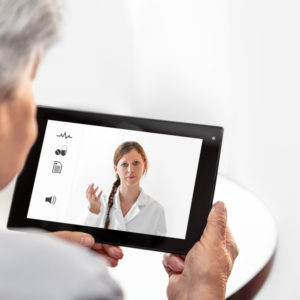The same virus that added social distancing and face masks to our daily routines has also helped inspire a new wave of healthcare technology.
And the timing couldn’t be better: Now that once-skeptical doctors have embraced virtual visits, advancements in telemedicine are poised to modernize our entire healthcare experience.
While even seeing friends and family can put someone at risk, telemedicine has allowed doctors and patients to interact safely. This includes texting, phone calls, Facetime or other means of conducting a virtual appointment.
During these visits, doctors can diagnose and treat many conditions such as sinus infections, bronchitis, pink eye, rashes, or allergies. It’s no wonder Medicare beneficiaries — those most at-risk for COVID — saw a 340 percent increase in telemedicine usage since the virus began.
It’s even useful for mental health visits, something a colleague of ours discovered when his teen daughter was struggling with social isolation due to the virus. Thanks to telemedicine, she was able to get her prescription adjusted to support herself during this stressful time.
These types of virtual visits are just the beginning: There are endless wearables, apps, biosensors and devices that can improve how we use telemedicine.
Wearables, including Apple Watches or Fitbits, are already popular devices that count activity levels, heart rate, sleep and more.
In fact, over 40 percent of people report using them to monitor their health, including almost 30 percent of those aged 64 and older. They also have built-in capabilities that can help establish baselines for a patient, which a doctor might never have seen before.
If we can share that data with our doctors, we only enhance the doctor’s ability to fully capture a patient’s condition, make the appropriate diagnosis, and develop the treatment plan.
That’s the goal for the next generation of wearables, which will include technology that takes blood pressure readings, EKG’s, oxygen saturation and more.
Google has already released a new open connector that is designed to facilitate data collection from multiple sources (i.e. wearables, telemedicine platforms, etc.). Once collected, the platform would apply machine learning capabilities to provide diagnoses electronically.
If that doesn’t sound futuristic enough, enhancements like infrared thermometers, camera adapters that enable a detailed view of the ear, nose and throat, and a myriad of other devices are currently being developed — which could raise the bar for the capabilities of the devices you use every day.
Our mobile devices also enable external data gathering through a sensor or camera, turning a cell phone into a potentially lifesaving medical tool. Imagine if your device could detect early signs of COVID-19 and monitor you outside of the hospital?
If you’d be interested in such a device, you’re not alone. Almost 80 percent of people said they would consider using one. Similarly, of those 64 and older, 43 percent would wear a device that helped maintain social distancing, and alerted others if they were too close. When it comes to these device add-ons, it seems the sky’s the limit.
This new wave of technology also changes the way we use and transmit digital medical records. That’s an incredible benefit for patients who may see a different virtual doctor during each telemedicine visit. This scenario once meant having to restate your medical history each time. Now, the entirety of your medical history is readily available.
Being able to digitally transmit all pertinent medical information prior to a virtual visit will also make doctors more efficient, while enabling them to provide a more accurate diagnosis.
Already, more than half of people said they received coronavirus updates and information from automated technology — why shouldn’t the same be true for doctors receiving data from patients?
Additionally, these advances in medical record technology allow patients to receive treatment much faster, which is crucial in an emergency situation.
Taken together, these medical advances could bring about a new generation of telemedicine that takes the burden off of medical personnel who are already spread too thin.
Telemedicine was already gaining popularity with consumers — over 30 percent reported using it during the crisis. Almost 60 percent of those aged 64 and older have reported using telemedicine at least once.
But the coronavirus finally encouraged much of the medical community to jump on the bandwagon. Even after things return to “normal,” we suspect doctors and patients alike will continue to utilize these healthcare advancements.

